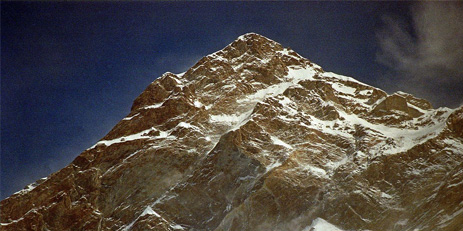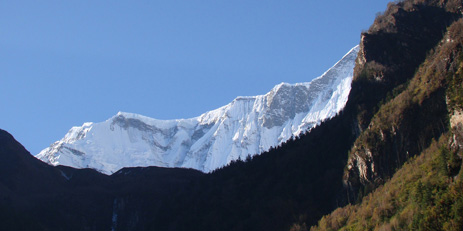 Annapurna is an enormous Himalayan massif, the tenth highest mountain in the world. In 1950, it became the first 8,000 meter mountain to be successfully climbed. It is located east of a great gorge cut through the Himalaya by the Kali Gandaki river. The mountain has glaciers on its western and north-western slopes which drain into this gorge. Annapurna is a sanskrit word which when broken down, would mean, "Sustenance" and "filled with". So the name would translate into "The Goddess rich in Sustenance" or simply "The Provider". It was first climbed by M. Herzog & L. Lachenal in 1950.
Annapurna is an enormous Himalayan massif, the tenth highest mountain in the world. In 1950, it became the first 8,000 meter mountain to be successfully climbed. It is located east of a great gorge cut through the Himalaya by the Kali Gandaki river. The mountain has glaciers on its western and north-western slopes which drain into this gorge. Annapurna is a sanskrit word which when broken down, would mean, "Sustenance" and "filled with". So the name would translate into "The Goddess rich in Sustenance" or simply "The Provider". It was first climbed by M. Herzog & L. Lachenal in 1950.
The Annapurna Himal and the Lamjung Himal stretch from the Kali Gandaki in the west to the Marshyangdi in the east. Four summits make up Annapurna with the entire massif forming a barrier on the northern side of the Pokhara Valley in Nepal. The main summit stands to the west of the Annapurna Sanctuary. Little was known about the mountain until 1949 when Dr. A. Heim from the windows of a Dakora aircraft viewed Dhaulagiri and Annapurna. The aircraft could not fly high enough for proper observation or for photographs, still the next year, June 3rd 1950, Annapurna was conquered. It was the first eight thousanders to be climbed, this feat was accomplished by the French. However, all the routes on the mountain pose severe difficulties and hence it is probably why fewer climbers have reached the summit in comparison to other 80000m peaks. A stunning peak lies on the western part of Nepal. This mountain had summated by Maurice Herzog and his expedition team on the date of 3 June 1950. Probably, the team was the first to set a new record in the world mountaineering history by successfully climbing a peak over 8,000meters. The team was first who granted permission to attempt to climb Mt. Annapurna I, by the Nepalese government.
A stunning peak lies on the western part of Nepal. This mountain had summated by Maurice Herzog and his expedition team on the date of 3 June 1950. Probably, the team was the first to set a new record in the world mountaineering history by successfully climbing a peak over 8,000meters. The team was first who granted permission to attempt to climb Mt. Annapurna I, by the Nepalese government.
Important Note and Optional Activities
Your safety is of paramount concern whilst traveling with Himalayan Trail Blazer . Please note that your leader has the authority to amend or cancel any part of the itinerary if it is deemed necessary due to safety concerns. Every effort will be made to keep to the above itinerary; however, as this is adventure travel in remote mountain region, we cannot guarantee it! Weather conditions, health condition of a member, unexpected natural disasters, etc., can all contribute to changes in the itinerary. The leader will try to ensure that the trip runs according to plan, but please be prepared to be flexible if required.











